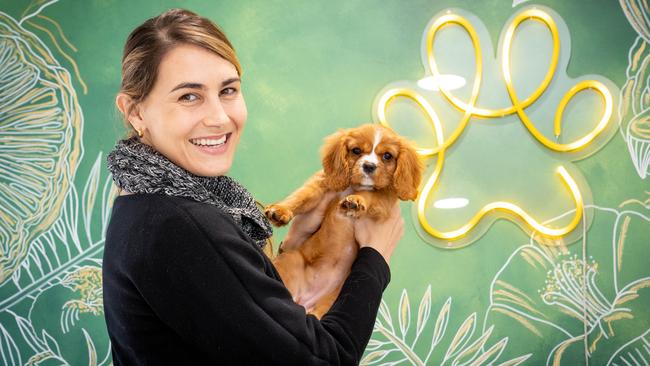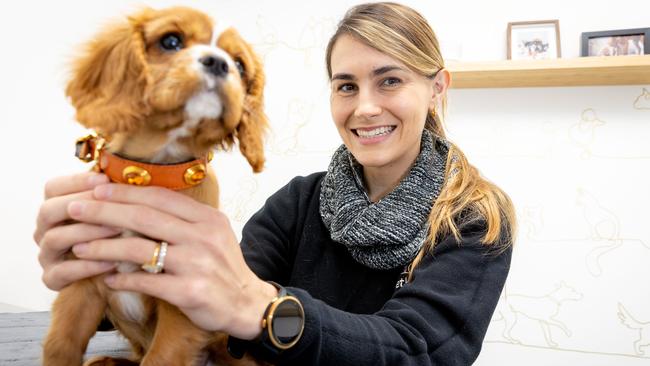Pet insurance policies are soaring at Medibank and Bupa
Pet insurance is changing and major funds see a gold rush opportunity as huge numbers of younger owners insist on top cover for their beloved animals.

Elvis might as well have sung “you ain’t nothing but a pound dog”, with pet insurance becoming the latest boom industry as the price of dogs and cats soar.
As some dog breeds sell for almost $10,000, more Australians are taking out pet insurance policies, putting their furry friends in the same category as cars and jewellery.
Overall, the pet industry in Australia is now worth about $13bn, and despite households feeling the pinch from the Reserve Bank’s aggressive interest rate rises to tame inflation, Australians are not scrimping when it comes to caring for their animals.
Australia’s biggest health insurer Medibank wrote 70 per cent new pet insurance policies last financial year, with growth remaining strong.
Chief executive David Koczkar said one in five families have bought a new pet during the pandemic.
“There has been a huge uptake of pet ownership over the last couple of years. Going forward, our aspiration is to support the lives of the household and make sure all family members are safe, secure and have peace of mind with their health, and pets are part of the family,” Mr Koczkar said.
The price of pet insurance varies on a range of factors, including type of cover, breed and age of the pet. On average, an annual plan will cost around $300, and with the RSPCA estimating there are more than 29 million pets in Australia, it’s no wonder health insurers are seeking to capitalise on the trend.

But for Brisbane veterinarian Remona Horn it is money well spent. She said Australia’s health system meant people had limited understanding of health costs, which created bill shock when an animal is ill.
“There are groodles that sell for $5,000, $8000, $9000 and you either have clients that pay that amount of money and say they’ve got that amount of money to pay (again) if something goes wrong. But they don’t realise that if something really goes wrong, the bill can be really significant,” Dr Horn said.
“Because we have got Medicare in Australia, people in Australia see private health has a bit of a luxury.
“People get it because they prefer to go to a private hospital rather than a public one. Whereas in pets, you don’t have that option.”
This leaves vets being forced to euthanise pets if their owners cannot pay for treatment or do not have pet insurance, which Dr Horn said was one of the contributing factors to a national vet shortage.
“Let’s say, worst case scenario a $20,000 bill, they have to eat, so if they literally do not have the money … then you basically know that you have to put down an animal that is definitely capable of recovering.
“From market research a couple of years ago, on average vets stay in practice for five years before they go out and do something else.”
Pet medication is also more expensive than human medication, given it is not manufactured on as big a scale. With the extra costs of food, grooming, dental and parasite prevention, Dr Horn’s advice is clear to potential pet owners: “if you cannot afford to pay the insurance premium every month, you can’t afford the pet”.
“Part of the reason for the explosion in pet insurance is its rapid evolution in the past decade. Ten years ago, policies offered limited coverage, wiht many owners questioning their value.”
Some policies did not cover conditions predisposed to certain breeds, like intervertebral disc disease which affects mainly dachshunds, leaving owners potentially thousands of dollars out of pocket.
But now insurers are offering more comprehensive policies and even reviews for pre-existing conditions.
Pet Insurance Australia spokeswoman Nadia Crighton said about 20 per cent of Millennials were taking out pet insurance for their cats and 27 per cent for their dogs.
This compares with 12 per cent of Baby Boomers taking out pet insurance for their dogs and 9 per cent for cats.
But more younger people can remain under their parents’ health insurance policies after the former Morrison government lifted the maximum age for dependants from 24 to 31 years last year.
Bupa general Insurance general manager Shannon Orbons said the maximum amount that it paid out year under its pet policies was $14,994, while the average claim was $366.
“There has been a significant boom in pet ownership during the pandemic with about one million dogs added as household pets during the first 18 months alone. Lockdowns and work from home arrangements gave people a better opportunity to become pet owners and we’ve seen our pet insurance business grow by more than 10 per cent,” Mr Orbons said.
“During the past 12 months, typical cases have included pets involved in car accidents, pets suffering eye or neurological conditions and pets with cancer.
“Pet insurance has helped many people give their pets the treatment they deserve, when they need it and given some claims could potentially cost pet owners thousands of dollars, taking some pressure off household budgets which we know are under strain from ongoing cost of living pressures.”
The RSPCA said although every pet’s individual needs vary, the average cost of owning a dog can add up to $1627 a year, while the average annual cost of owning a cat is around $962.
“Unfortunately, many pet owners aren’t fully aware of the costs that can arise when caring for their pet. These may be routine care costs, costs due to injury or illness or even due to health problems that their pet may be predisposed to,” the RSPCA said
“In total, it’s estimated that Australia’s pet industry is now worth around $13bn a year. This means that on top of having the highest rate of pet ownership, we’re also among the highest spending nations when it comes to our furry friends.”



